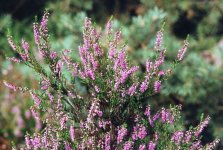Heather vulgaris hull.
Family Heather - Ericaceae
Botanical characteristics. Evergreen shrub. Rhizome is powerful, with long subordinate roots. Stems abundantly branching, reach a meter length, lie down, and branches rise up. Leaves are small linear-lanceolate, arranged cristae in four rows. Flowers are small light purple, located loose in unilateral bunches. Blooms in August - September, fruiting until October. The fruits are small, dark.
Spread. It grows in light forests, on soils poor in lime.
Used parts of the plant. Medicinal raw materials are the aerial part of the plant, less often the roots collected during the vegetative period in the usual way. Dry in the shade.
Chemical composition. All parts of the plant contain phenols and their derivatives: arbutin; Phenolic carboxylic acids: chlorogenic, coffee, synapic, n-coumaric, protocatechum, vanillin, gentisinic; Coumarins: esketuin, scopoletin; Catechins.
The roots and shoots contain protoanthocyanidins, in the stems - leucoanthocyanidins. The leaves contain organic acids: fumaric, lemon; Flavonoids: quercetin, herbacetin; tannins. Flowers (pollen) contain steroids: sitosterol, stigmasterol, methylene cholesterol, vitamins, pigments, microelements.
Application. The aerial part of the plant is official in Germany as a hypnotic and diuretic remedy.
In scientific medicine used to treat cancer.
In folk medicine in the Czech Republic and Slovakia, heather is used in the form of tea, as a soothing, diaphoretic, emollient, conducive to sputum production. In Norway, Germany, Poland, Hungary hepar preparations are used for rheumatism, cystitis, fever, skin diseases, like hemostatic, hypnotics, with diabetes, atherosclerosis, purulent inflammation of the urinary tract.
Decoctions and infusions are used inside as an expectorant for coughing, pulmonary tuberculosis, antiseptic, anti-inflammatory, with diseases of the bladder and kidneys, kidney stone disease, pyelitis, cystitis, urethritis, ascites, rheumatism, gout; As an astringent for diarrhea, dysentery, enterocolitis, hyperacid gastritis, liver and spleen diseases.
In folk medicine of our country, the roots and the aerial part in the form of broths are used for pulmonary tuberculosis, nervous disorders, gastric diseases: externally for washing wounds and ulcers. In homeopathy - with diseases of the bladder, as a diuretic, with rheumatism.
In the experiment, the extract showed a moderate hypothermic and hypotensive effect, promoted the acceleration of blood coagulation. Antibacterial activity of heather preparations was also established.
Powder of leaves, flowers and roots are applied externally - as hemostatic , wound-healing, analgesic; Poultices and baths - with radiculitis, diseases of rheumatoid nature. Fresh juice of a flowering plant is used to treat eye diseases, tumors, eczema, burns, skin diseases, edema.
Preparation
- To get the infusion, take 20 g of leaves, flowers or a mixture thereof, pour 200 ml of boiling water, insist on a boiling water bath for 15 minutes, cool for 45 minutes, filter. Take 1/3 cup 2-3 times daily before meals.
- For broth take 10 g of the aboveground part or roots, insist on a boiling water bath for 30 minutes, cool 10 minutes, filter. Take 2 tbsp. Spoon 3-4 times daily before meals.
- Tincture from the roots or seeds is prepared on 70% alcohol at the rate of (1: 5), insist in a dark place for 12-15 days, filter. Take 30-40 drops at the reception 3-4 times a day before meals.




Comments
Commenting on, remember that the content and tone of your message can hurt the feelings of real people, show respect and tolerance to your interlocutors even if you do not share their opinion, your behavior in the conditions of freedom of expression and anonymity provided by the Internet, changes Not only virtual, but also the real world. All comments are hidden from the index, spam is controlled.